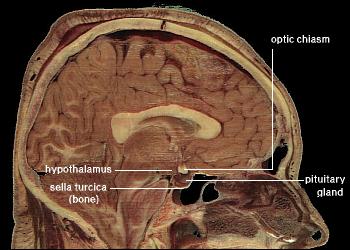All vertebrate brains contain hypothalamus, which in humans, it is roughly the size of an almond and constitutes less than 1% of the brain. It is located below the thalamus, just above the brain stem ( located on the ventral part of the diencephalon).
The main function of the hypothalamus is homeostasis, or maintaining the body’s internal environment constant. Factors such as blood pressure, body temperature, fluid and electrolyte balance, and body weight are held to a precise value called the set-point.
Although this set-point can migrate over time, from day to day it is remarkably fixed.
One of the most important functions of the hypothalamus is to link the nervous system to the endocrine system via the pituitary gland (hypophysis). The hypothalamus is responsible for certain metabolic processes and other activities of the autonomic nervous system.
The hypothalamus synthesizes and secretes neuro-hormones, often called hypothalamic-releasing hormones. These in turn stimulate or inhibit the secretion of pituitary hormones.
The hypothalamus controls body temperature, hunger, thirst, fatigue and circadian rhythm.
The hypothalamus contains several types of neurons responsible for secreting different hormones which include:
1. Releasing hormones:
- Thyrotropin-releasing hormone (TRH)
- Gonadotropin-releasing hormone (GnRH)
- Growth hormone-releasing hormone (GHRH)
- Corticotropin-releasing hormone (CRH)
2. Inhibitory Hormones:
- Somatostatinor Growth Hormone Inhibitory Hormone
- Dopamine or Prolactin Inhibitory Hormone
3. Neuroendocrine Function:
Oxytocin and antidiuretic hormone (ADH also known as vasopressin) are also produced within the hypothalamus, but they travel through the neurons to the posterior pituitary, from where they are released into the blood or stored.
All other hormones are released directly into the blood and travel through the portal veins. They reach a second capillary bed, located in the anterior lobe of the pituitary, where they bring about their effects.
Thyrotropin-releasing hormone (TRH)
TRH is a tripeptide (Glu-His-Pro), released from the parvocellular neurosecretory neurons. It stimulates the release of thyroid stimulating hormone (TSH) from the anterior pituitary, which acts on the thyroid gland to increase its secretions. It also stimulates the release of prolactin from anterior pituitary.
Gonadotropin-releasing hormone (GnRH)
GnRH is a peptide containing 10 amino acids and is secreted in a pulsatile manner occuring every 1 to 2 hours from the neuroendocrine cells preoptic area. Its secretion after the onset of puberty brings about the sexual development, by acting on the anterior pituitary bringing about the release of FSH and LH.
Growth hormone-releasing hormone (GHRH)
GHRH is a mixture of two peptides, one containing 40 amino acids, while the other 44 released by neuroendocrine cells of arcuate nucleus. Growth hormone releasing hormone acts on the cells in the anterior lobe of the pituitary to secrete growth hormone (GH). Growth hormone is essential for normal growth and development.
Corticotropin-releasing hormone (CRH)
CRH is a peptide of 41 amino acids released from parvocellular neurosecretory neurons. Corticotropin releasing hormone acts on the cells in the anterior lobe of the pituitary to release adrenocorticotropic hormone, which acts on the adrenal gland to increase its hormone production. CRH is also produced by the placenta and the has some role in determining the duration of pregnancy.
Dopamine or Prolactin Inhibitory Hormone (PIH):
Dopamine is derived from the amino acid tyrosine, released from the dopamine neurons of arcuate nucleus. Its main function in the hypothalamus is to inhibit the release of prolactin (PRL) from the anterior lobe of the pituitary.
Somatostatin or Growth Hormone Inhibitory Hormone(GHIH)
Somatostatin or GHIH contains two peptides, one of 14 amino acids, the other of 28 released from neuroendocrine cells of periventricular nucleus. Somatostatin inhibits the relase of growth hormone and the thyroid stimulating hormone by acting on the anterior pituitary.
Somatostatin is also secreted by cells in the pancreas (delta cells in Islets of Langerhans) and in the intestine where it inhibits the secretion of many other hormones.
Vasopressin and Oxytocin
These peptides are released from the posterior pituitary upon stimulus but are produced within hypothalamus. These are produced within the supraoptic and paraventricular nuclei and are transported within neurons to posterior pituitary, where they are stored. They are released upon appropriate stimuli.
 howMed Know Yourself
howMed Know Yourself


